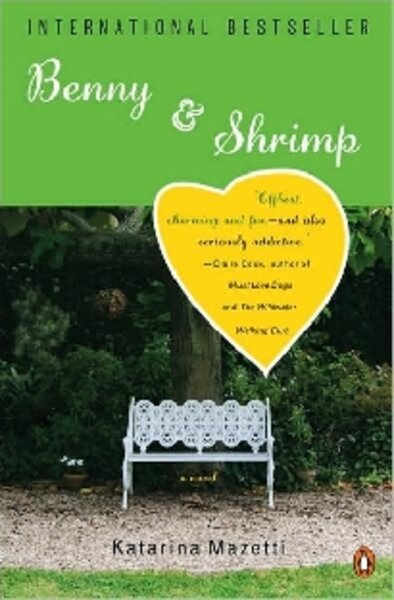Benny & Shrimp
Loading...
Like it or not, the summer is drawing to a close. But if you’re hoping to squeeze in at least one more charming book before Labor Day, I have a couple of titles to recommend.
In the case of these two books, however, it’s probably one or the other and not both. By nature they are most likely to appeal to different constituencies.
The first is Benny & Shrimp, originally written in Swedish by Katarina Mazetti and translated into English by Sarah Death. If the title immediately makes you think of that other Swedish charmer, “Astrid & Veronika” by Linda Olsson, you’re on the right track. Both are sweet stories about the unexpected warmth that can blossom between two lonely characters.
But for Benny and Desirée (Shrimp is his nickname for her, because she’s “pale, curled around her soft parts, with her shell on the outside”), it’s more than romance. It’s the kind of love that some argue comes only once in a lifetime.
And yet it shouldn’t have come to Benny and Desirée. They’re just too different. Desirée is a 30-something urbanite. A librarian, she cherishes books, opera, spare décors, and vegetarianism. Benny, on the other hand, is a farmer. Not the modern kind that stuff their own sausages and do fancy woodwork for their front porches but more your grandmother’s farmer – the type that subsist on frozen foods and hang counted cross-stitch in their farmhouses.
By rights this mismatched couple should never have crossed paths. But they do. Both recently bereaved and lonely (her husband was hit by a bus and his beloved mother has passed on) they meet at the cemetery. Although at first they annoy each other, eventually Benny flashes her a smile and what Desirée suddenly sees are “sun and wild strawberries and birds singing and expanses of glittering water.” In short, she is smitten, in a way that she never was with her more urbane husband.
Benny, for his part, thought he was looking for a curvaceous female who might understand a thing or two about the dangers of hoof rot and the rigors of the crop cycle. But instead he discovers that the greyhound-thin Shrimp has a “dry, husky laugh” that becomes a reward for which he’ll do “almost anything.”
Genuine as their feelings are, it is evident that Benny and Shrimp’s romance will not be without its complexities. His unchic social set appalls her and he “kick[s] out like a cross cow” when she tries to lead him “up the cultural path.” Prepare for trouble ahead. And also be forewarned that “Benny & Shrimp” plays fast and loose with traditional morality. The ending arrives with rather a jolt, and suffice it to say that if you did not approve of the fourth season of “Murphy Brown” this probably isn’t your book. If you like an offbeat love story, however, this one is as sweet and unexpected as the wild strawberries Shrimp glimpses in Benny’s smile.
The second book is the first in a projected series. Lois Barker is a 30-something single journalist working at a city paper in Dayton, Ohio, when Ed, her best friend at work, suddenly drops dead. To her great surprise, she discovers that he has left her the “Green News-Item,” a small-town newspaper in northwest Louisiana. She can sell it – but only if she first moves to Green and spends a year running it.
It’s an appealing premise for a novel and Gone to Green by Judy Christie makes an engaging read. (Engaging and nostalgic – it was pleasant to be reminded that there really was a time when you could make a living by running a newspaper.) While much of “Gone to Green” is predictable (the good ol’ boys who run the town turn out to be rotten apples, a sullen-seeming teenager turns into a great kid with lots of potential, and the good-looking catfish farmer down the road proves more interesting than Lois first suspected), it is also warm-hearted and good-natured.
Green is the kind of town where cellphone reception is weak, the town square includes a monument to the boll weevil, and everybody knows your name. The ratio of good people to bad weighs heavily in favor of the good and in some respects – despite the heat and “humisery” – it’s the kind of town most of us at least occasionally daydream about inhabiting. But it’s also riddled with racism and rotten real estate deals and Lois can’t resist throwing the force of her little newspaper into the fight against them.
In real life, Christie lives in northwest Louisiana and her firsthand knowledge of small towns shows in her writing. She resists the temptation to make the town folk a collection of likable oddballs. Instead, Green is populated by real people with real concerns, who sometimes show the occasional flash of interest in culture and the outside world, even as they attend church socials and support the local Catfish Festival.
Christie describes her fiction style as “inspirational,” which means that her characters sometimes pray for answers and occasionally find themselves in church. Lois is a crusader who wants to make her new hometown a better place to live even as she longs to feel sure that there’s a place for her in God’s larger plans. You never seriously doubt that she’ll find it.
Does “Gone to Green” have a formulaic feel? It does – rather like a faith-based Nancy Drew story for adult readers. But that won’t necessarily stop you from reaching for the next installment.
Marjorie Kehe is the Monitor’s book editor.






